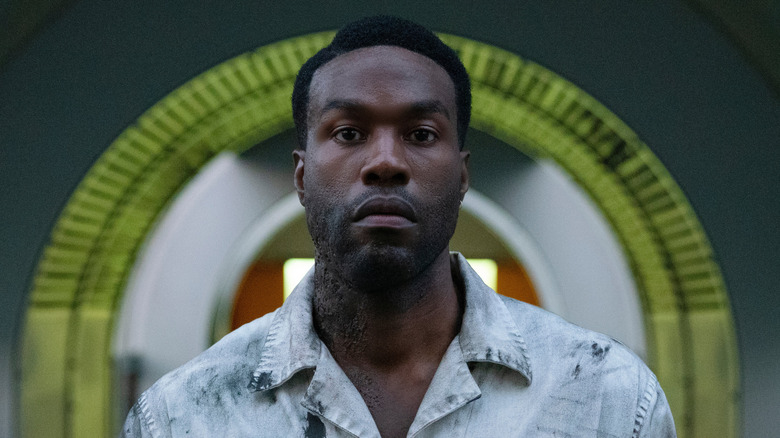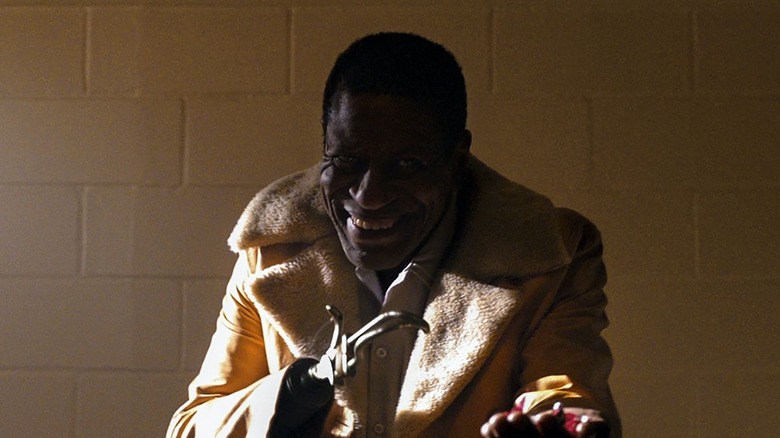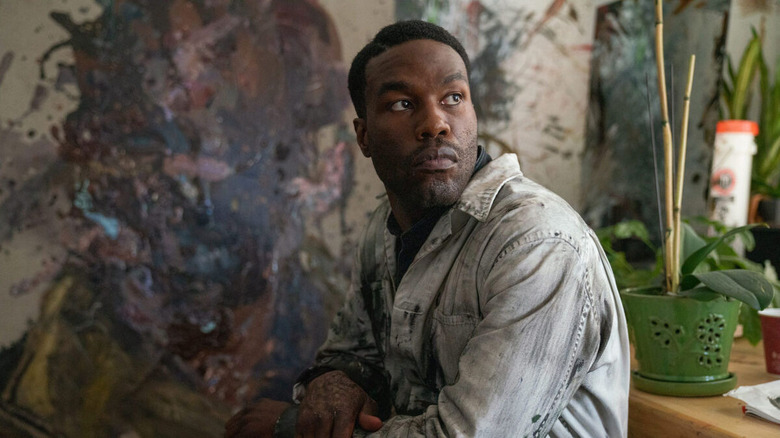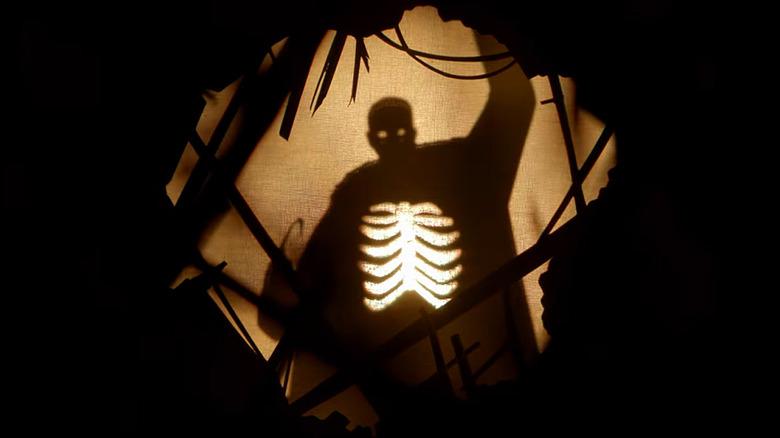Candyman Spoiler Review: Nia DaCosta Combines Trauma And Martyrs With A Terrifying Myth
Is Candyman real?
The characters of Nia DaCosta's legacy sequel begin to ponder this question when the answer reaches its deadliest point. They mine the legend of the supernatural killer for inspiration and laugh at the ridiculous notion that a ghost can be summoned by the repetition of his name. But even when they make light of his existence, there's an understanding of his power. Brianna (Teyonah Parris) brushed off Anthony's (Yahya Abdul-Mateen II) suggestion that they perform the ritual and summon Candyman's ghost. Her brother, Troy (Troy Nathan Stewart-Jarrett), doubles down, decisively stating, "Black people don't need to be summoning sh*t."
Fear of Candyman ripples through the Chicago neighborhood of Cabrini-Green long after its projects have been overtaken by luxury condos and its Black residents have been pushed to the outskirts. But when the wealthy elite come to occupy Cabrini's echo, the story still manages to reach them. What could be more real than that? Does Candyman need to be tangible if he can haunt people through just a name?
Over the past weekend, DaCosta's "Candyman" has been making waves and breaking records. Where the box office is concerned, the film has exceeded expectations — and the same can be said for the movie itself. Of course, we had high expectations for DaCosta after her astonishing debut "Little Woods," not to mention the fact that the cast for "Candyman" is overflowing with talent. But the marketing also cleverly hid the fascinating depths of DaCosta's latest, selling it as a popcorn slasher with some self-awareness. In reality, "Candyman" has more to say that it can even manage, which is both its best and worst quality.
I'm a strong proponent of movies trimming their fat, but "Candyman" is a tight 90 minutes. There's so much more it could've explored with an extra 15 minutes — especially in its third act. But beyond what could've been is all that we got. Nia DaCosta's film is rich and ripe for dissection, delving into the lives of complicated characters wading through painful emotions.
Revisiting The Legend of Candyman
Once a sacrificial lamb claimed by Tony Todd's terrifying original Candyman, baby Anthony is all grown up. He's now an artist searching for inspiration, desperate to reclaim his career and continue on as the "great Black hope" of the Chicago art scene. But when it comes to Anthony, the question of sacrifice continues to hang over his head — what will he compromise for the sake of his career? Our first hint comes when he presents his latest work to curator Clive Privler (Brian King) and pitches an idea about his childhood home, Southside Chicago. When Clive starts to shoot him down, Anthony quickly settles on Cabrini-Green, a neighborhood he's so unfamiliar with that he misspells it in his initial google search.
Thus, Anthony sets out on a Helen Lyle-esque journey, digging into the myth that haunts the neighborhood. Helen is the protagonist from the original 1992 "Candyman" whose death draws Anthony further down the rabbit hole, leading him to follow in her footsteps and retrace her trek through the neighborhood. But unlike Helen, Anthony's connection to Cabrini-Green is deeper. As he'll later learn — and as those familiar with the first film already knew — Anthony isn't new to the neighborhood.
"Candyman" retreads a lot of familiar territory. Anthony's movements are reminiscent of the original film as he seems to spiral down a similar path. Fascination with Candyman led Helen to tragedy and we quickly sense the same will become of Anthony as he comes to terms with the myth's true danger. He's told and retold the story of Candyman throughout the film, and in those moments of shadowy pantomime, we are shown gut-wrenching violence.
This seems to be the core of the film: the repetition of violence and the long-term effects of generational trauma.
The Trauma Remains
The story of "Candyman" begins with a Black man brutally murdered by a mob, repeated in DaCosta's version when yet another innocent Black man is killed by a swarm of police officers. Not too far from reality, Black trauma is inescapable in the world of "Candyman." Each character ping-pongs between experiencing violence and bearing witness to it, with those like William Burke (Colman Domingo) and Anthony becoming participants. Even as the film approaches its end, we continue to learn about the pain baked into characters' backstories, including that of Brianna.
As for Anthony, his trauma is so detached that he doesn't truly understand until it the film's end. Even still, the violence eats away at him, with his body drastically deteriorating. By the time Burke has strapped him to a chair, sawed off his hand, and plunged a hook into the open wound, Anthony is beyond feeling pain. His mind is so far gone, so thoroughly consumed that the violence enacted on his body hardly seems to register.
DaCosta's film thrives in these moments when given the space to explore her characters' complexities and the wider world of their pain.
Through Anthony, we get a dissection of art and appropriation. He doesn't hesitate to use the myth of Candyman in his artwork, eager to show off "depth" to an art critic and the gallery's overwhelmingly white audience. Meanwhile, Brianna grapples with her own place in the art world, struggling to pave her path forward, all the while having her trauma preyed on by those interested in the narrative she has to offer. Colman Domingo's performance as Burke is rife with emotion and possibly the most complex of them all. His story entwined with Anthony's explores the nature of martyrdom.
The Memory Lives On
We learn in flashbacks that summoning Candyman led to the death of Burke's sister. That trauma compiled with witnessing further violence in his youth. He explains to Anthony that he believes the legend of Candyman is a necessary one, as it's a way of dealing with all the pain. Hoping to keep the legend alive for another generation, he plots Anthony's death. In the third act, Burke calls the cops, hoping they will murder Anthony and continue the legend of Candyman. Sure enough, they deliver, shooting the incapacitated Anthony rather than providing medical assistance.
According to Burke, Candyman is a way to deal with injustice. Though it may cost an innocent life, it will be worth the memory that lives on. He stands starkly opposed to Brianna, who pushes her trauma out of sight. Near the climax, her brother warns, "you can't just hide everything and hope it goes away." Perhaps Brianna thinks of this in the film's final moments, cuffed in the back of a cop car and being threatened with life in prison. Finally, she speaks Candyman's name into a rearview mirror. He comes to her rescue as Anthony, murdering the surrounding officers. Moments later, his face disappears.
DaCosta's myth collides with reality, showcasing the hollow truth of martyrdom. Making a person into a symbol isn't only horrific, but inherently flawed. It dismisses their personhood entirely, erasing their memory. In the end, Anthony is obscured into the face of the many Candymen that came before him. And while their names are forgotten, only the terrifying legend lives on.



